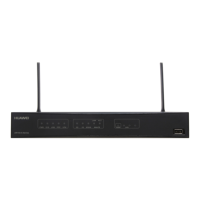4.4.1 Establishing the Configuration Task
Before configuring local flow mirroring, familiarize yourself with the applicable environment,
complete the pre-configuration tasks, and obtain the required data. This will help you complete
the configuration task quickly and accurately.
Applicable Environment
An intranet has high requirements for information security and privacy protection. You can
configure mirroring on an interface to monitor incoming and outgoing data packets. The
management server that has the monitoring software installed can capture these packets for
analysis and fault location.
To monitor and analyze the packets with some characteristics passing through the mirrored
interface that is located on the same AR150/200 as the observing interface, configure local port
mirroring on the AR150/200.
Pre-configuration Tasks
None.
Data Preparation
To configure local flow mirroring, you need the following data.
No.
Data
1 Type and number of the observing interface
2 Type and number of the traffic mirrored interface
3 Names of the traffic classifier, traffic behavior, traffic policy, and traffic classification
rules
4.4.2 Configuring a Local Observing Interface
The local observing interface is used to export the packets copied from the mirrored interface.
Context
After an interface is configured as the observing interface, other configurations are not
recommended on the interface. Otherwise, the following situations may occur:
l If other service traffic exists on the observing interface in addition to mirrored packets, the
packet source cannot be differentiated.
l If congestion occurs on the observing interface, mirrored packets may be discarded because
the priority of mirrored is low.
Procedure
Step 1 Run:
Huawei AR150&200 Series Enterprise Routers
Configuration Guide - Device Management 4 Mirroring Configuration
Issue 02 (2012-03-30) Huawei Proprietary and Confidential
Copyright © Huawei Technologies Co., Ltd.
64

